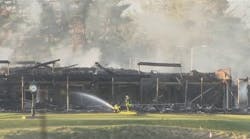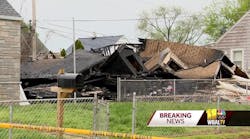It’s no secret that fire tankers and tenders are at a higher risk of rollover than any other fire apparatus on the road today. Heavily loaded tankers with higher centers of gravity, short wheelbases and sometimes poorly converted gross vehicle weight ratings (GVWRs) have proven to be one of leading causes of firefighter injuries and fatalities decade, after decade.
The U.S. Fire Administration has identified fire apparatus accidents as a leading cause of firefighter injuries and fatalities. Today, according to USFA’s statistics, 25% of on-duty fatalities occur while responding to or returning from an incident. As a cause of firefighter fatalities, it is second only to heart attacks.
While tanker and tenders represent only 3% of fire apparatus operating in the United States today, the USFA found that over a 12-year period, tankers and tenders were responsible for 22% of all fatalities among firefighters. Some of the exposure to risk and accidents is due to tanker and tender conversions, while other reasons for the high rate of tanker and tender accidents – many of which are rollover incidents – can be traced to inadequate driver training and poor vehicle maintenance. To better understand what can be done to improve safety, handling and stability of a high center gravity, and heavily loaded tankers and tenders, HME has taken a closer look at the all of the factors that contribute to these accidents.
Preventing rollovers
Preventing tanker rollovers begins with understanding how easily big rigs, like tankers and tenders, can roll over. Tankers and tenders account for a large percentage of all fire apparatus accidents and an even higher percentage of fatalities in accidents that look, on the surface, to be avoidable. So what are the causes behind these accidents and rollovers? And even a better question is what can be done to prevent them?
It’s just a fact of nature that high-center-of-gravity trucks, like tankers and tenders, roll over more easily than other types of vehicles. While such vehicles as passenger cars have a lower susceptibility to rollover because they can’t achieve the g’s (approximately 1.3 g’s for a passenger car) to roll over while cornering, a half-empty tanker with a poorly maintained suspension could easily attain the speed to reach enough g’s (it may take only 0.04 g’s) to tip over. Contact with a debris or a curb could also initiate a rollover, even at very low speeds. In fact, vehicles with high centers of gravity can roll over at speeds as low as 5 mph, even when backing up. Proper driver training and understanding of the dynamics of a rollover, as it relates to tankers, is probably one of the best ways to improve safety for firefighters.
Repurposed vehicles
“On June 21, 2005, a 52-year-old male volunteer chief died from injuries sustained during a tanker rollover.” That’s from a line-of-duty investigation report by the National Institute for Occupational Safety and Health (NIOSH). Unfortunately, you don’t have to look hard to find stories like this one. The chief in this case was a highly experienced and trained firefighter. He was driving a military-surplus truck that had been converted into a tanker to a nearby town for a state inspection. While he was driving on a gravel road at approximately 40 mph, the left-front tire of the tanker ruptured, causing a loss of control. The tanker left the road and rolled over several times. The chief was ejected and died on the scene from his injuries.
As we can see from just this one incident, an accomplished and experienced chief, driving at a reasonable speed, found himself in a situation where loss of control and stability occurred before he could take any action to prevent the rollover. In some cases, the potential for a hazardous accident was part of the vehicle itself.
While the incident appears to have been caused by a blowout, it could also be seen as a tragic combination of many of the factors that play a role in a large number of tanker and tender accidents – especially in tankers that have been converted or repurposed. In this case, NIOSH investigators offered these actions as a way of reducing this particular type of accident.
1. Enforcement of standard operating procedures for seatbelt use.
2. Determine safe operating weights for water tankers based on vehicle characteristics.
3. Remove overweight vehicles from service.
4. Identify and correct defects and deficiencies in government surplus vehicles prior to being released to the fire service.
Many communities and fire departments seek to contain or reduce apparatus costs by repurposing or converting government surplus vehicles, milk trucks or gasoline haulers. While dollars may be saved, it’s a cost-saving practice that can put firefighters at significant risk in a number of ways.
A mistake many departments make when using a tanker originally built and designed to carry a liquid other than water is overloading (see Emergency Vehicle Operations, “Are You Really Driving a Fire Truck?” March 1997). Overloading occurs when the conversion of fluid weights aren’t accounted for correctly. Repurposed gasoline tankers could present the worst-case scenario – water weighs more than two pounds per gallon more than gasoline. Some departments set a limit on the amount of water loaded into repurposed tankers, but there’s always the risk the tanker will eventually be filled beyond the set limit and become dangerously overloaded.
And even if overloading is avoided, a partially filled tanker is at just as high a risk of rollover as it is from overloading by the effects of sloshing as it is by overloading. Departments that convert tankers and tenders sometimes use tanks meant for static applications without the tank baffles found in quality fire tankers and tenders. Converting vehicles by slicing or modifying the frame also creates additional dangers by weakening rails and raising the potential of chassis failure. Chassis modification can also create an unstable and often dangerous, higher center of gravity than the suspension – or even an experienced driver – can handle.
Safer tankers and tenders
HME engineers have long understood the importance of building balanced a well-engineered tankers and tenders – with correct GVWRs to match the vehicles maximum loads – and baffled tanks to prevent sloshing and shifting loads. HME has also recognized the need for greater roll-stability, braking and suspension control – especially in the at-risk world of tanker and tenders. New transportation regulations are already on the way that will mandate suspension control systems in the near future – systems that HME is integrating into its fire apparatus, tankers and tenders right now.
HME worked with a provider of suspension and braking control systems, Meritor WABCO, developing advanced suspension control and braking systems for fire tankers and tenders. The advanced electronic stability control systems integrated into HME tankers and tenders automatically sense when there is a risk of directional instability that could lead to a loss of vehicle control and cause a rollover. The technologically advanced control system constantly compares a vehicle’s actual movement to performance models through its integrated sensors. If the vehicle shows a tendency to leave the driver’s steering path, through understeering or oversteering, or if the vehicle exceeds a critical lateral acceleration limit, the system will prevent loss of control by selectively applying brakes to realign the vehicle in accordance with the driver’s intended direction of travel.
While apparatus manufacturers can design and build safer and more stable tankers for the future, a large measure of firefighter safety, especially in the operation of these big rigs, remains in the hands of individual fire departments. Seatbelt mandates and specialized driver training programs are key elements to turning around the alarming rate of accidents and fatalities in tanker and tender operation. Improved maintenance and inspection routines are a key role in improving tanker and tender safety. Chiefs and municipalities need to look at their tanker and tender expenditures and realize that these specialized fire apparatus may not be the best place to cut costs – because their firefighters’ lives are on the line each time a tanker or tender leaves the firehouse to answer the call.







